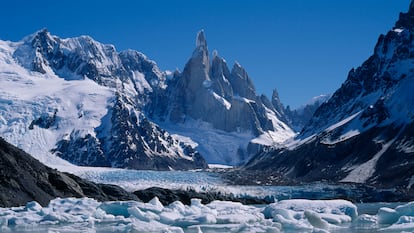Life and death in Patagonia: The toughest decision to make in a mountain rescue
Tomy Aguiló of Argentina and Korra Pesce of Italy sustained a serious accident while climbing the famous Cerro Torre, and only one of them could be saved

All the beauty of an imposing landscape, the magic of isolation, the simplicity of climbing in the company of a friend, the longed-for peace, the protection from the cold afforded by top-quality gear; everything that makes mountaineering an exercise in escapism and contentment was swept away in seconds and replaced by a scenario of pain and terror.
Surprised by an ice and rock landslide in the early hours of the morning, climbing experts and guides Tomy Aguiló, 36, from Argentina and Korra Pesce, 41, from Italy, quickly understood that the world they had believed to be safe just hours before had disappeared and they had not yet outsmarted death. As if hit by a shell in a war zone, it took the pair a moment to understand the extent of their injuries. Tomy could stand up; Korra could not. Their gear had all but gone and they were still halfway up a rock face trying out a new route – a new milestone in their impressive climbing careers.
The accident took place on January 28 on Cerro Torre in Patagonia, in Argentina, in what is one of the most difficult, isolated and iconic mountains on the planet. Far from any trace of civilization, a rescue operation is always challenging here: unlike in Europe, there are no official rescue teams or helicopters. There is, however, the El Chaltén Rescue Committee, a volunteer but well-trained rescue team set up at the end of the 1990s by Dr Carolina Codó, and which relies on the solidarity of climbers passing through to respond to any call for help. That Tomy Aguiló was able to call for help at all was a miracle: while trying to gather together what little equipment was still serviceable, he found his small Inreach device – a satellite messaging gadget. He then helped Korra reach the remains of a tiny roofless shelter on the wall known as Box of the English, where the Italian confirmed that a fractured pelvis prevented him from standing up.
Suffering himself from several broken ribs and a broken collarbone, Tomy got hold of a 40-meter (131-ft) piece of rope and began a slow and dangerous descent. Tomy and Korra are both family men and mountain guides, and whenever Korra traveled to Patagonia, he stayed with Tomy. In the European summer, Tomy would stay at Korra’s house in Chamonix, where Korra was considered a true local legend. A cheerful individual with a spontaneous laugh, Tomy speaks about his friend with heartfelt admiration. They will never see each other again.
Dr. Codó confirmed on January 30 that Tomy was in good condition and recovering at El Calafate hospital in Santa Cruz. “Unfortunately, we have decided to cancel the rescue operation for Korra,” she said. “It is a very tough decision, but the window of good weather is over and it is impossible that he is still alive, given his injuries: without shelter, food or drink, he would have died of hypothermia by now. We have also been able to scan the mountain using a drone and we have seen that he was 50 meters below where Tomy left him and was not moving. To put the rescuers’ lives at risk would be irresponsible,” she added.
More than 35 people came to the pair’s rescue. Without them, Tomy would not have survived. “The rescuers reached him 26 hours after he raised the alarm,” said Dr Codó. “He descended by rappelling down until he reached a snowfield where he waited some 300 meters above solid ground, exhausted.” Four top mountaineers – Matteo Della Bordella of Italy, Roger Schaeli of Switzerland, Thomas Huber of Germany and Roberto Treu of Argentina – were involved in the final part of the rescue and managed to climb the last stretch of rock face to reach Tomy.
Della Bordella and Schaeli tried to continue climbing up to save Korra while the other two descended with Tomy, but an abrupt change in the weather forced them to retreat. “We were already well beyond our physical and psychological limits and we understood that Korra would stay on the mountain forever,” Della Bordella said. He and his two fellow Italian companions had crossed paths with Tomy and Korra on the summit of Cerro Torre on January 27 – the day before.
According to Dr. Codó, ironically, “the Italians were also opening a new route on the east face and joined Tomy and Korra when they were finishing their route on the north face, so they hooked up, but the Italians decided to sleep on the summit and descend the next day via the so-called Compressor Route while Tomy and Korra chose to descend at night on the north face to avoid avalanches.”
Korra Pesce was not only a legend in his adopted Chamonix, in France, but a highly respected and beloved figure among Spanish alpinists: together with Martín Elías from the northern Spanish region of La Rioja, he had climbed the now famous Rolling Stones route in 2015 on the Grandes Jorasses mountain between France and Italy, and the Directe de l’Amitié on the same mountain a year earlier. And in 2016 they had repeated the Impossible Star on Bhagirati III (6,454m or 21,174ft) in the Indian Himalayas together, along with two French companions. Korra Pesce also hooked up with Spanish climber Manu Córdova in 2012 to climb Aguja Mermoz and Torre Egger, in Patagonia. A gifted mountaineer with an impressive vision, technique and strength, Korra seemed untouchable; every goal he set for himself was achieved.
Tomy and Korra’s parting words will forever remain something private between them. But given Korra’s understanding of the essence of mountaineering, one can only imagine that he understood his situation and that, given the conditions, a rescue was not going to happen. It is all conjecture, of course, but it is not hard to surmise that he strongly encouraged Tomy to at least try to save his own life.
Tu suscripción se está usando en otro dispositivo
¿Quieres añadir otro usuario a tu suscripción?
Si continúas leyendo en este dispositivo, no se podrá leer en el otro.
FlechaTu suscripción se está usando en otro dispositivo y solo puedes acceder a EL PAÍS desde un dispositivo a la vez.
Si quieres compartir tu cuenta, cambia tu suscripción a la modalidad Premium, así podrás añadir otro usuario. Cada uno accederá con su propia cuenta de email, lo que os permitirá personalizar vuestra experiencia en EL PAÍS.
¿Tienes una suscripción de empresa? Accede aquí para contratar más cuentas.
En el caso de no saber quién está usando tu cuenta, te recomendamos cambiar tu contraseña aquí.
Si decides continuar compartiendo tu cuenta, este mensaje se mostrará en tu dispositivo y en el de la otra persona que está usando tu cuenta de forma indefinida, afectando a tu experiencia de lectura. Puedes consultar aquí los términos y condiciones de la suscripción digital.










































